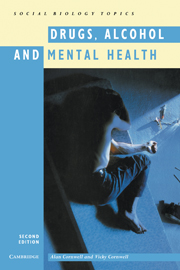Book contents
- Frontmatter
- Contents
- Preface
- 1 Drugs and drug abuse
- 2 Socially acceptable drugs
- 3 Misuse of prescribed and related drugs
- 4 Hallucinogenic drugs
- 5 Opiates and other narcotics
- 6 The biology of alcohol
- 7 The problems of alcohol use
- 8 Prevention and control of alcohol problems
- 9 Help for problem drinkers
- 10 Mental health and mental illness
- 11 Alzheimer's disease and other dementias
- 12 Other mental illnesses
- Further reading
- Index
8 - Prevention and control of alcohol problems
Published online by Cambridge University Press: 05 June 2012
- Frontmatter
- Contents
- Preface
- 1 Drugs and drug abuse
- 2 Socially acceptable drugs
- 3 Misuse of prescribed and related drugs
- 4 Hallucinogenic drugs
- 5 Opiates and other narcotics
- 6 The biology of alcohol
- 7 The problems of alcohol use
- 8 Prevention and control of alcohol problems
- 9 Help for problem drinkers
- 10 Mental health and mental illness
- 11 Alzheimer's disease and other dementias
- 12 Other mental illnesses
- Further reading
- Index
Summary
Introduction
The number of people whose drinking is above safe limits, in other words the people for whom drinking causes problems, is related to the proportion of the population in any society who drink alcohol. These problems are many and varied, and it is therefore in the interests of both the individual and the state that some attempt is made to control consumption and thus minimise the problems. This can be approached in different ways, by controls which emphasise the disadvantages of drinking and by education which enables people to understand more about alcohol and hopefully exercise a greater control over their own drinking.
Availability and licensing laws
Prohibition would seem to be the ultimate and obvious solution. In some Moslem countries there are prohibition laws with severe penalties for infringement. They operate with a fairly high degree of success, but this is probably because alcohol is forbidden by religious law. In countries where drinking is common and there is no widespread religious opposition, similar legislation has never been effective. In the USA the Prohibition Law of the 1920s was unpopular and in fact triggered a wave of organised crime with the gangster syndicates importing and distributing liquor. This law was repealed in 1933 because it was unworkable.
A more realistic approach to the control of consumption is to restrict the hours during which alcohol may be sold, that is by imposing licensing hours.
- Type
- Chapter
- Information
- Drugs, Alcohol and Mental Health , pp. 68 - 74Publisher: Cambridge University PressPrint publication year: 1993



